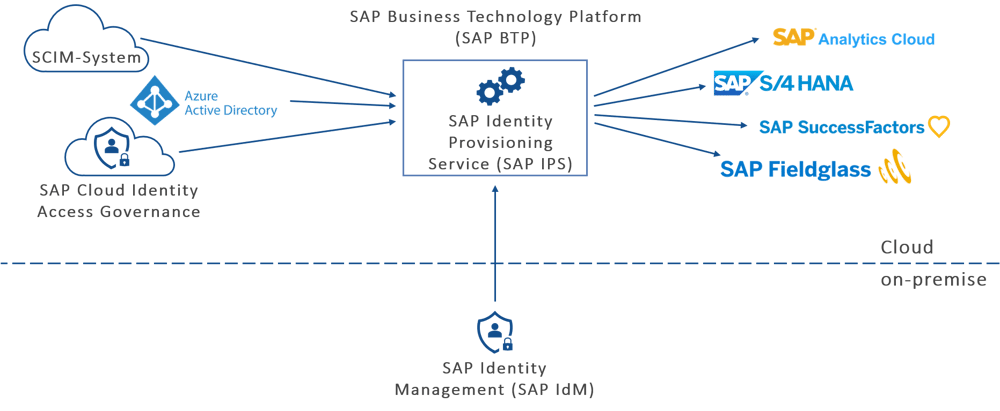As a service on SAP Business Technology Platform, SAP Identity Provisioning (IPS) ensures the integration of on-premise and cloud systems in the identity lifecycle. By using the standardized SCIM 2.0 protocol (SCIM = system for cross-domain identity management), SAP and non-SAP systems can be connected equally flexibly.
There are different approaches to integrating SAP IPS into the system landscape. Basically, SAP Identity Provisioning is a service that connects a source system and a target system. Accordingly, it is necessary to connect a source system, from which the identities and authorization objects are loaded, and a target system, into which the identities and authorizations are written, to SAP IPS.

Our most used connectors:
A complete overview of all IPS connectors is available on SAP Help. |
SAP Identity Provisioning can also be used as a proxy system. In this scenario, SAP IPS is connected to an existing SAP Identity Management. In SAP IdM, SAP IPS is then a connected system, but it serves as a proxy for another system (usually a cloud system).

Cloud-based service for identity lifecycle management
Manage users, roles, and groups in cloud and hybrid landscapes
Based on the SCIM industry standard
Single sign-on for browser-based applications (cloud and on-premise)
Different authentication options
Different user store integration scenarios
Centralized management of risk and compliance for on-premise and cloud
Reduced role management complexity through streamlined design and governance
Policy-driven workflow processes for access management and certification

The integration between the SAP and Microsoft world is still a task that is not easy to accomplish. The challenge of integration becomes particularly clear when matching user data to build a common user base, which is essential for seamless working with the correct authorizations.

The reality of enterprise IT landscapes is hybrid. On-premise and cloud systems exist in parallel and must be seamlessly connected. For the management of authorizations, a hybrid system landscape means a certain challenge.

Automate your Identity Management processes in the cloud. Use the new SAP Cloud Identity services (Identity Provisioning and Identity Authentication) to establish an interface for all your cloud systems.
Simply complete the form and submit it. We will get back to you as soon as possible.

Identity lifecycle management is part of enterprise security and describes all processes for assigning roles and authorizations − from when an employee joins the company, through changing responsibilities or even department changes, to when he or she leaves.

SAP Identity Management focuses on the traceable management and consistent distribution of digital identities throughout their lifecycle – assignment, repeated adjustments, deletion.

SAP Single Sign-On enables end-to-end authentication against SAP and non-SAP applications. Central management of access data increases security, as only one user ID is required for all applications.